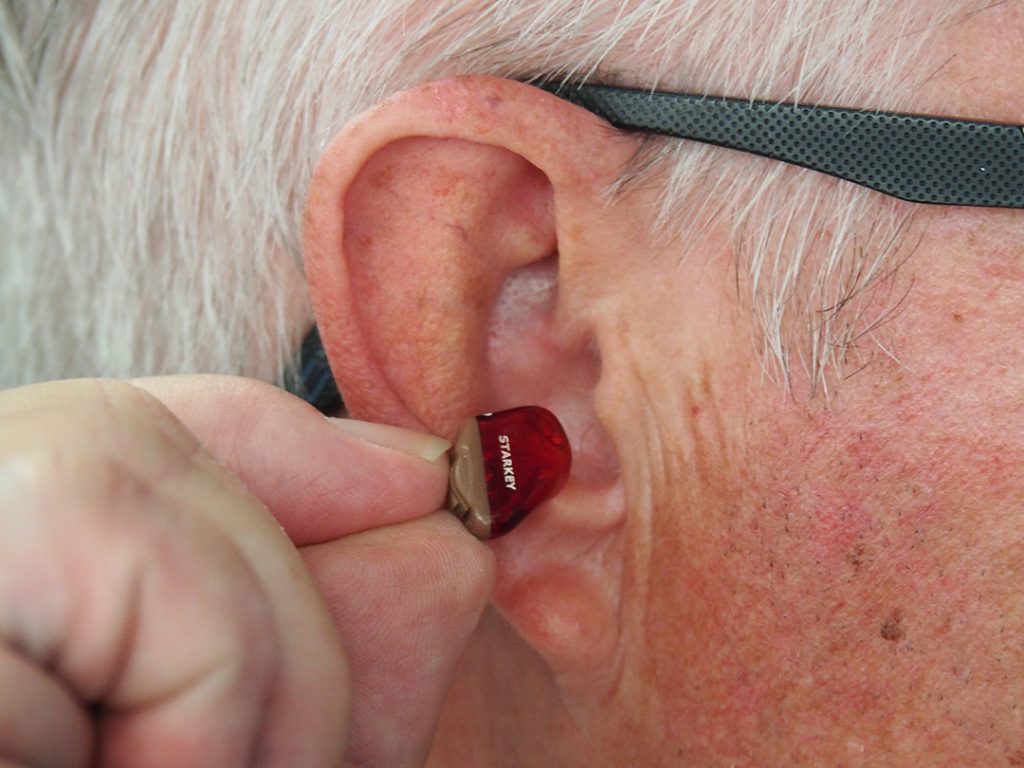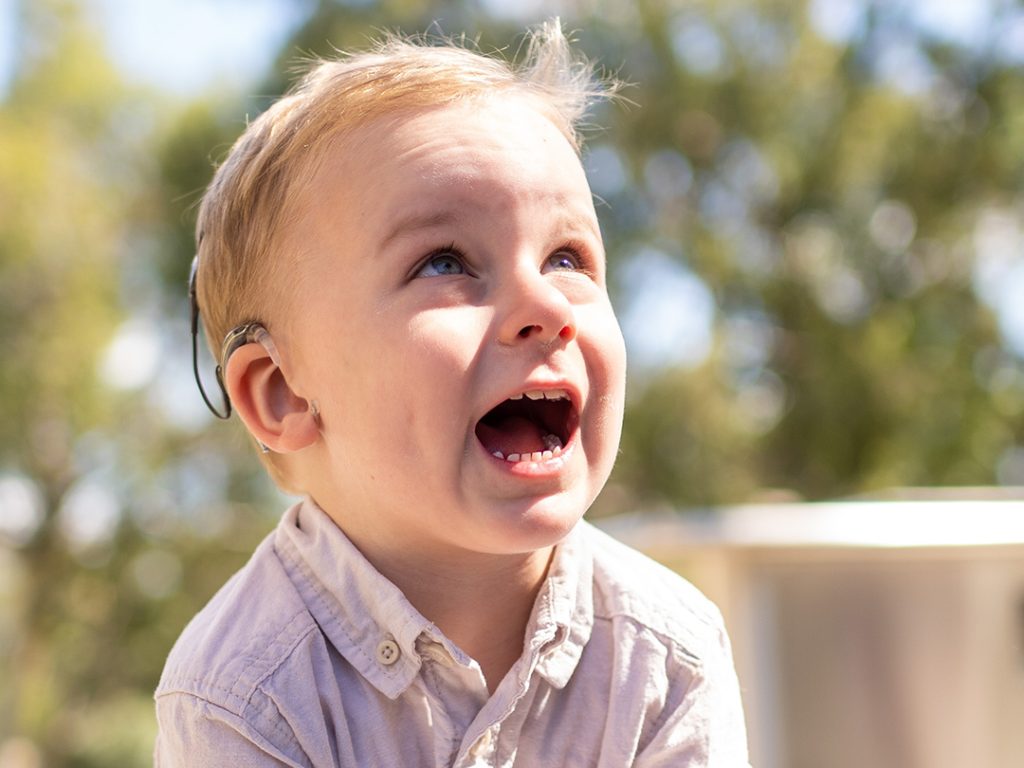If you suffer from hearing loss, there are several types of hearing aids that can correct or reduce the problem. Which type of hearing aid is right for you depends on your needs and desires.
Behind the ear (BTE)

The most well-known and widely used hearing aid is the so-called “behind the ear” aid. As the name suggests, the hearing aid itself is located behind the ear and the sound is delivered to your ear canal through a flexible tube and an earpiece.
BTEs with open fitting are the future. These have a dome instead of an earmold, which does not close off the ear canal. They are also smaller and therefore lighter than regular BTEs and the dome is less noticeable. Also, with open adjustments, the ear canal remains open and aerated. This increases comfort and reduces the risk of ear canal irritation.
Advantages
- They can compensate for most types of hearing loss, including more severe hearing loss
- They are available in very small models
- They are easy to operate and maintain
- They are less prone to interference than an “in the ear” device
Cons
- More visible than ‘in the ear’ devices
- They are more sensitive to perspiration
- They are not stable with wide protruding ears
- The function of the directional ears in the auricle is lost
- With prolonged use, the standard earpieces start to deform the ear canal, preventing the earpieces from staying in place
In the ear (ITE).

An “in the ear” device is worn in the ear, as you might expect. These devices are popular because they are quite unobtrusive. They come in three varieties. The concha model fills the entire auricle, a Mini-IHO (MIHO) fits inside the ear canal but is still visible, and a Completely in Channel (CIC) sits completely inside the ear canal. With the latter, only the wire you use to put it in and take it out is visible.
Advantages
- The small speaker sits in the ear canal and thus in a natural location. However, due to the limited space, there is less room for technical parts, so performance is also more limited.
- These devices are quite unobtrusive because they sit in the ear.
Cons
- They are more susceptible to damage from earwax, moisture or dust. Also, ITEs completely or almost completely close off the ear canal, which can lead to eczema or ear infections.
- They are often more expensive to purchase than larger hearing aids and have relatively high battery consumption.
- Conchas and MIHOs are relatively sensitive to whistles.
- The small size and placement in the ear canal cause some people to have difficulty inserting, removing and operating ITEs.
- CICs can only properly improve mild to moderate hearing loss. You must be handy to insert and remove the devices properly; many people find this difficult. Because of the small size, many CICs do not have room for a telecoil for the purpose of a telecoil.
- The diameter of the ear canal must be large enough to accommodate an ITE device
Cros appliance
If you are deaf in one ear, you cannot perceive sound signals on that particular side. To still make sounds perceptible to that ear, there is the so-called cros (contralateral routing of signals) device. This is a hearing aid on your deaf ear that transmits sound signals to your good ear via a wire or wireless system. With a crosstalk device, you cannot hear which direction the sound is coming from, but you can perceive sounds on the side of your deaf ear. If your best ear is also hearing impaired, you need a bicros system. This not only transmits the sounds to the best ear, but also amplifies the sounds.
Cochlear Implant (CI).

A CI (Cochlear Implant) is an electronic device that allows very hard of hearing and deaf people to hear again. A CI takes over the work of the damaged parts of the inner ear (cochlea) to deliver sound signals to the brain.
The implant consists of a thin silicone cord that is surgically inserted into the cochlea. At the end of the lead is a series of tiny electrodes. The sound signal is transmitted by the external processor through the magnetic coil to the internal part, where it electrically stimulates the auditory nerve at various locations through the electrodes. The electrodes are recalibrated repeatedly during the first few months for best listening results.
Advantages
- A CI is seen by many people as a miracle: It allows deaf and profoundly hard of hearing people to hear again. The CI mimics, so to speak, the hearing system of people with good hearing, which has about 3,000 sensory cells to transmit sound signals to about 30,000 nerve endings. Very hard of hearing and deaf people generally do not receive and process this signal. And that is where the CI comes in.
- If children or adults are barely able to perceive spoken language despite the help of hearing aids and hearing training, a cochlear implant may provide a solution
Cons
- For those without auditory memory, it is difficult to recognize heard sounds. So it is important to have or build an auditory memory. Receiving and translating sounds and thus understanding the other person often requires practice
- Sometimes you can also hear too much with a CI. While well-hearing people can supposedly block out disturbing sounds, with a CI they cannot. So a ticking clock can more easily interfere with listening to a conversation for those wearing a CI
- A CI does not always provide the ability to distinguish meaningful sounds from background noise
- With a CI, it is not always possible to determine which direction the sound is coming from
Bone anchored hearing aids
A bone anchored hearing aid is used for conductive hearing loss and also sometimes for people who cannot tolerate ear pieces. A bone anchored hearing aid transmits sound via vibration. The implant is a vibrating block surgically fixed in the skull. The microphone and amplifier vibrate the cube and thus the bone. This causes the cochlea to vibrate and the sound is transmitted.
There are currently two brands: the BAHA (Bone Anchored Hearing Aid) from Cochlear and the Ponto from Oticon Medical. In young children up to about 5 years of age, the vibration block cannot yet be secured in the skull. For this group, there is, for example, the BAHA with soft band, in which the vibration block is incorporated into a headband. Bone anchored hearing aids are also being used more and more recently as a crosstalk hearing aid for people with unilateral sensorineural hearing loss. The sound on the side of the bad ear is thus made audible to the good ear.
Fully implantable hearing aid
A fully implantable hearing aid is surgically inserted. With such a type of hearing aid, you can shower, swim and play sports, and you will not be bothered by wind noise, for example. A remote control is used to turn the hearing aid on, off and adjust it. After about five years, the battery needs to be replaced through an outpatient procedure. If necessary, new software can also be inserted at that time. Fully implantable hearing aids are suitable for various forms of hearing loss.
Frequently asked questions about types of hearing aids
What types of hearing aids are there and what are the differences?
The best-known types are “behind-the-ear” (BTE), “in-the-ear” (ITE), and “completely-incanal” (CIC). The difference is in size, visibility, power and wearing comfort. What suits you depends on your hearing loss and personal preference.
Are there hearing aids that are almost invisible?
Yes, the so-called CIC (Completely-In-Canal) devices and the IIC (Invisible-In-Canal) sit deep in the ear canal and are therefore barely visible. However, they are not suitable for every type of hearing loss.
What is the best hearing aid for someone with severe hearing loss?
It depends on the individual hearing curve and specific needs. Often, powerful behind-the-ear hearing aids give the best results for more severe hearing loss. Our hearing specialists will be happy to advise you based on a professional hearing test. Make an appointment now.
Can I try different types of hearing aids first?
At Horend Goed, you always have a trial period first. During this period, you test the device in your everyday environment. That way you can experience whether the type and functions suit you.
How do I know which type of hearing aid is most comfortable?
This is very personal. Some people prefer a small in-the-ear model, while others prefer a behind-the-ear model. A short fitting session and trial period will help to determine this.


You must be logged in to post a comment.